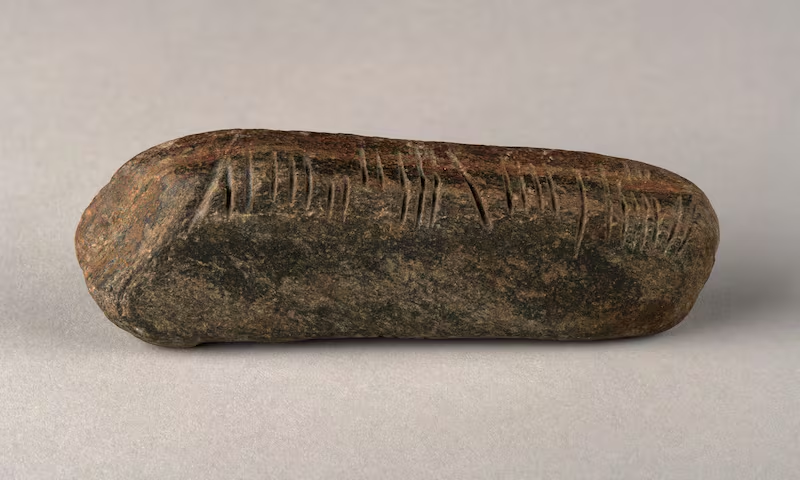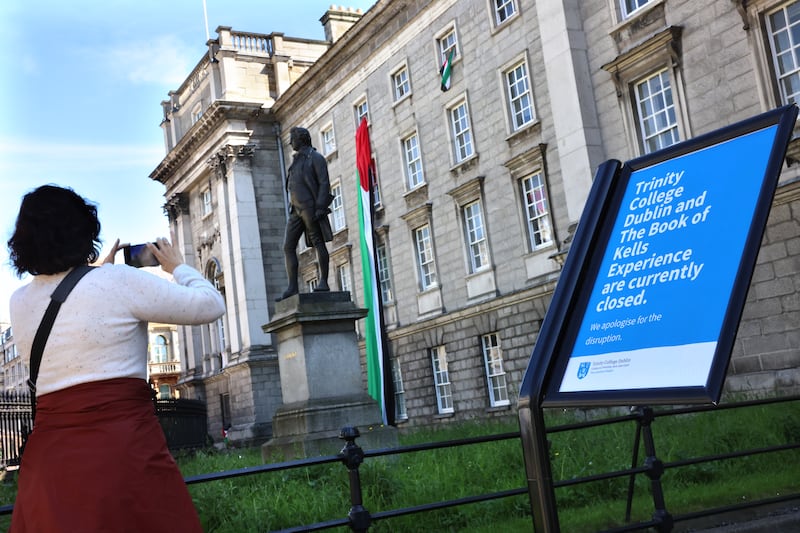A big week for Ogham on the international stage, showing up in a Coventry garden and also on Eurovision entrant Bambie Thug in Malmo, Sweden.
How did the singer get on with their (banned) pro-Palestine messages and (tolerated) pro-witch messages daubed in make-up as part of their stage get-up? “10/10,” proclaims Katherine Forsyth, professor of Celtic Studies at the University of Glasgow.
Some online Ogham translators deal with the system’s absence of a letter W by dropping it, but the Irish team in Sweden deployed two Us instead, creating CROUUN THE UUITCH, impressing the scholars.
“This shows that in fact a proper amount of thinking has gone into the Ogham used by the singer,” says Dr David Stifter, professor of Old Irish at Maynooth University
David Davin-Power, former RTÉ correspondent, dies aged 72
Former HSE manager shared child sexual abuse images of ‘utmost depravity’ online, Mayo court hears
Ballyfin restaurant review: ‘Downright dazzling, one of the most delicious things I’ve eaten this year’
We’re meant to bask in Saoirse Ronan’s feminist triumph, but I find it all a bit nauseating
Furthermore, any half-literate Gael who assumed there had been mistakes on Bambie Thug’s leg during rehearsals is looking at things from the wrong perspective entirely.
Dr Stifter says that in one case the “sidedness of the B- and the H-group of Ogham letters has been swapped”. But while “this gives the external reader the impression of a mistake”, it actually “makes sense from the perspective of the singer who sees them in the correct orientation”.
Coventry curiosity

More contentious, strangely, is the Ogham discovered on a stone in the garden of geography teacher Graham Senior in Coventry, as reported in The Guardian this week.
The 139g stone is something of an outlier, according to the OG(H)AM academic research project, which discussed it at a meeting this week.
“It is very unusual,” says Dr Stifter, a member of the team.
It’s the smallest stone object out of 460 that have been identified anywhere, for one thing.
The stone’s longest inscription, reported by The Guardian as perhaps a name, “Mael Dumcail”, is more likely to be “ILDUMCAIL or OULDUMCAIL (or perhaps, but less likely, AELDUMCAIL)”, says Dr Stifter, or “if it were read from the other side, it would be DIASMULDI”.
This is “unintelligible and contains no immediately recognisable Irish words or names”.
Is it a fake? Not necessarily – inscrutability is fairly common on portable Ogham-inscribed objects such as knives. And the carving is good.
“At the moment we are leaning towards the option that it probably is old,” says the professor.
Barry Keoghan at the Met
Pity the poor social media producer at New York magazine’s Vulture outlet who found out the hard way that responding to the sight of an Irishman by doing an offensive impression went out of style in the 19th century.
“Hello little lassie, couldja point me in da direction of me missus?” editorialised Vulture in a post on X featuring a photograph of actor Barry Keoghan attending the glitzy annual Met Gala. “She’s got a grand ‘me espresso’ at home that i better be drinkin’.”
Baffling on its face, but that’s supposed to be an approximation of an Irish accent – possibly an archaic one, inspired by Keoghan’s Regency dandy get-up. And the “me espresso” reference is to his girlfriend, pop star Sabrina Carpenter, and her latest hit, which features the unlikely refrain “that’s that me espresso” (sic).
Irish X users weren’t happy. “Jail for Vulture,” urged highbrow literary publisher Tramp Press. “Was this written by Jar Jar Binks?” asked poet James Conor Patterson. “This is a hate crime,” suggested many.
It’s not the first clash between US media and the plain people of Ireland in recent months, after Merriam Webster dictionary accused the name “Siobhán” of being unintuitive to pronounce and the New Yorker imagined Cork film star Cillian Murphy having a “hearty meal of potatoes” at the pub.
Perhaps it’s the price of success.
‘Great gospel’ on loan?

Whither the Book of Kells? The vellum tome’s brief separation from its €19-paying tourists during the Trinity Gaza protests has led to some discussion about whether it might be better off up the road in the National Museum of Ireland, or even further up the road in Kells.
But what about Iona, the holy island of Colmcille in Scotland’s southern Hebrides? With a population of 177, it doesn’t have quite the sway of Kells (population 6,600), Trinity (more than 21,000) or Ireland (5.1 million). But it does have a good claim.
Long before it was taken from Meath to College Green for safekeeping, the “great gospel” was taken from Iona to Meath by monks fleeing Vikings, or so the theory goes. So do the Scots want their heritage restored?
“The Book of Kells is the embodiment of the close familial, historical and cultural links that exist between our two great Celtic nations,” Brendan O’Hara, the SNP MP for Argyll and Bute tells us.
“I fear, however, that that could all be put in jeopardy if Scotland was to try and lay claim to the Book of Kells and seek its return to Iona. The diplomatic furore that could follow such a request is unimaginable.
“Of course if the book were ever to be loaned to Scotland, I would love to see it returned, even temporarily, and put on display at Iona Abbey.”
Remembering Steve Albini
This week, we learned of the sudden death of Steve Albini, the legendarily austere audio engineer responsible for recording albums by everyone from Nirvana to baroque-folk harpist Joanna Newsom. In a busy career, Albini also clocked up several credits with Irish artists including Adrian Crowley and The Frames, and a surprising number of rambunctious US-based trad-rock/punk outfits such as The Drovers and Ballydowse.
To Colm Mac Con Iomaire, a member of The Frames, he was a “prince”. To Lurgan’s Malojian, he was “very generous” and “very funny”.
But with all that, he was also businesslike, according to the Young Dubliners, a California outfit who had the “amazing experience” of recording with the great man in the mid-1990s, even bumping a session with Led Zeppelin’s Jimmy Page and Robert Plant off his schedule to mix the release.
“He arrived with one small backpack for three days,” recalls Keith Roberts, currently on the road in Kansas City. “The bag was completely full of microphones and a pair of underwear – he had his priorities straight.”
- Sign up for push alerts and have the best news, analysis and comment delivered directly to your phone
- Find The Irish Times on WhatsApp and stay up to date
- Listen to our Inside Politics podcast for the best political chat and analysis




